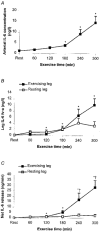Production of interleukin-6 in contracting human skeletal muscles can account for the exercise-induced increase in plasma interleukin-6
- PMID: 11080265
- PMCID: PMC2270169
- DOI: 10.1111/j.1469-7793.2000.00237.x
Production of interleukin-6 in contracting human skeletal muscles can account for the exercise-induced increase in plasma interleukin-6
Abstract
1. Plasma interleukin (IL)-6 concentration is increased with exercise and it has been demonstrated that contracting muscles can produce IL-The question addressed in the present study was whether the IL-6 production by contracting skeletal muscle is of such a magnitude that it can account for the IL-6 accumulating in the blood. 2. This was studied in six healthy males, who performed one-legged dynamic knee extensor exercise for 5 h at 25 W, which represented 40% of peak power output (Wmax). Arterial-femoral venous (a-fv) differences over the exercising and the resting leg were obtained before and every hour during the exercise. Leg blood flow was measured in parallel by the ultrasound Doppler technique. IL-6 was measured by enzyme-linked immunosorbent assay (ELISA). 3. Arterial plasma concentrations for IL-6 increased 19-fold compared to rest. The a-fv difference for IL-6 over the exercising leg followed the same pattern as did the net IL-6 release. Over the resting leg, there was no significant a-fv difference or net IL-6 release. The work was produced by 2.5 kg of active muscle, which means that during the last 2 h of exercise, the median IL-6 production was 6.8 ng min-1 (kg active muscle)-1 (range, 3.96-9.69 ng min-1 kg-1). 4. The net IL-6 release from the muscle over the last 2 h of exercise was 17-fold higher than the elevation in arterial IL-6 concentration and at 5 h of exercise the net release during 1 min was half of the IL-6 content in the plasma. This indicates a very high turnover of IL-6 during muscular exercise. We suggest that IL-6 produced by skeletal contracting muscle contributes to the maintenance of glucose homeostasis during prolonged exercise.
Figures


Comment in
-
Interleukins and exercise.J Physiol. 2000 Nov 15;529 Pt 1(Pt 1):1. doi: 10.1111/j.1469-7793.2000.00001.x. J Physiol. 2000. PMID: 11080244 Free PMC article. No abstract available.
Similar articles
-
Interleukin-6 production in contracting human skeletal muscle is influenced by pre-exercise muscle glycogen content.J Physiol. 2001 Dec 1;537(Pt 2):633-9. doi: 10.1111/j.1469-7793.2001.00633.x. J Physiol. 2001. PMID: 11731593 Free PMC article.
-
Supplementation with vitamins C and E inhibits the release of interleukin-6 from contracting human skeletal muscle.J Physiol. 2004 Jul 15;558(Pt 2):633-45. doi: 10.1113/jphysiol.2004.066779. Epub 2004 May 28. J Physiol. 2004. PMID: 15169848 Free PMC article. Clinical Trial.
-
IL-6 and TNF-alpha expression in, and release from, contracting human skeletal muscle.Am J Physiol Endocrinol Metab. 2002 Dec;283(6):E1272-8. doi: 10.1152/ajpendo.00255.2002. Epub 2002 Aug 20. Am J Physiol Endocrinol Metab. 2002. PMID: 12388119 Clinical Trial.
-
Exercise and interleukin-6.Curr Opin Hematol. 2001 May;8(3):137-41. doi: 10.1097/00062752-200105000-00002. Curr Opin Hematol. 2001. PMID: 11303145 Review.
-
Muscle-derived interleukin-6: lipolytic, anti-inflammatory and immune regulatory effects.Pflugers Arch. 2003 Apr;446(1):9-16. doi: 10.1007/s00424-002-0981-z. Epub 2003 Feb 18. Pflugers Arch. 2003. PMID: 12690457 Review.
Cited by
-
Interleukin 6 receptor is not directly involved in regulation of body weight in diet-induced obesity with and without physical exercise.Front Endocrinol (Lausanne). 2022 Oct 27;13:1028808. doi: 10.3389/fendo.2022.1028808. eCollection 2022. Front Endocrinol (Lausanne). 2022. PMID: 36387898 Free PMC article.
-
Differential responses of serum and salivary interleukin-6 to acute strenuous exercise.Eur J Appl Physiol. 2005 Mar;93(5-6):679-86. doi: 10.1007/s00421-004-1241-z. Epub 2004 Nov 20. Eur J Appl Physiol. 2005. PMID: 15778897
-
Effect of Exercise Interventions on Irisin and Interleukin-6 Concentrations and Indicators of Carbohydrate Metabolism in Males with Metabolic Syndrome.J Clin Med. 2023 Jan 3;12(1):369. doi: 10.3390/jcm12010369. J Clin Med. 2023. PMID: 36615169 Free PMC article.
-
Central and Peripheral Fatigue in Physical Exercise Explained: A Narrative Review.Int J Environ Res Public Health. 2022 Mar 25;19(7):3909. doi: 10.3390/ijerph19073909. Int J Environ Res Public Health. 2022. PMID: 35409591 Free PMC article. Review.
-
Sirt6 reprograms myofibers to oxidative type through CREB-dependent Sox6 suppression.Nat Commun. 2022 Apr 4;13(1):1808. doi: 10.1038/s41467-022-29472-5. Nat Commun. 2022. PMID: 35379817 Free PMC article.
References
-
- Andersen P, Adams RP, Sjogaard G, Thorboe A, Saltin B. Dynamic knee extension as model for study of isolated exercising muscle in humans. Journal of Applied Physiology. 1985;59:1647–1653. - PubMed
-
- Bernéus B, Carlsten A, Holmgren A, Seldinger SI. Percutaneous catheterization of peripheral arteries as a method for blood sampling. Scandinavian Journal of Clinical Laboratory Investigation. 1954;6:217–221. - PubMed
-
- Bruunsgaard H, Skinhoj P, Qvist J, Pedersen BK. Elderly humans show prolonged in vivo inflammatory activity during pneumococcal infections. Journal of Infectious Diseases. 1999;180:551–554. - PubMed
Publication types
MeSH terms
Substances
LinkOut - more resources
Full Text Sources
Other Literature Sources
Medical
Molecular Biology Databases
Miscellaneous

